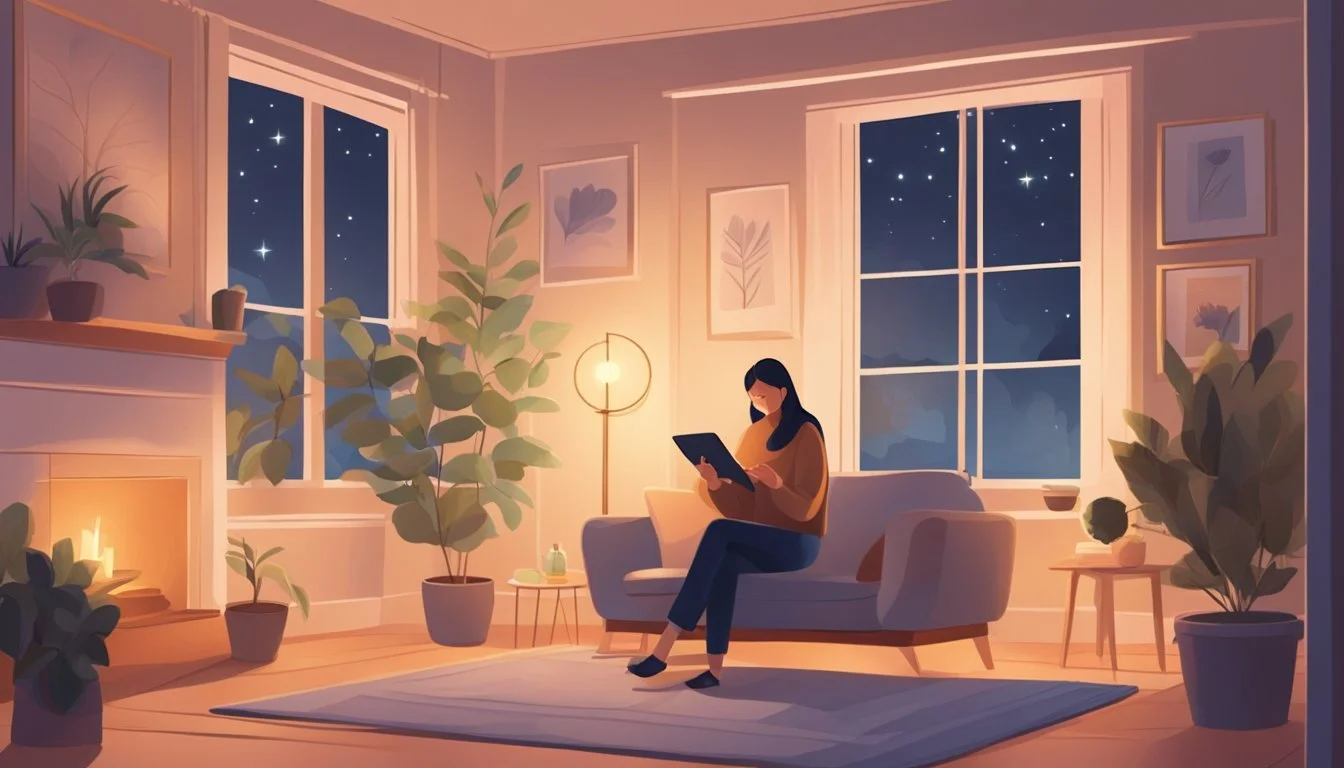13 Grounding Techniques for Managing PTSD-Related Acrophobia
Practical Strategies
Managing PTSD-related acrophobia, or the intense fear of heights, requires effective coping strategies. Grounding techniques are valuable tools that help individuals stay connected to the present moment and reduce anxiety triggered by fear-inducing situations. These techniques often involve engaging the senses or employing cognitive distractions to manage distressing emotions.
Grounding techniques offer immediate relief by helping individuals reclaim control during anxiety episodes. This can be especially beneficial for those who experience overwhelming fear when confronted with high places. By incorporating these methods, individuals can improve their quality of life and face acrophobia with more confidence and resilience.
1) Grounding Visualizations
Grounding visualizations are a powerful technique for managing PTSD-related acrophobia. By mentally placing oneself in a calming or safe environment, individuals can reduce anxiety and regain control.
Visualizing a favorite place, such as a beach or forest, can create a sense of peace. Focus on the sounds, smells, and sights of this place to make it as vivid as possible.
Another effective method is to visualize leaving behind distressing feelings. Imagine placing them in a box and locking it, or visualize them floating away like a balloon.
Using specific colors in visualizations can also be helpful. Think of colors that evoke calmness, such as blue or green, and imagine being surrounded by these hues. This can provide immediate relief from stress.
For a more interactive approach, visualize engaging activities. Picture oneself engaging in a hobby or sport they love. This not only distracts the mind but also reaffirms personal strengths and positive experiences.
Practicing these visualizations regularly can enhance their effectiveness, making it easier to employ them during moments of acute stress. Remember, consistency is key in grounding exercises.
2) Deep Breathing Exercises
Deep breathing exercises are essential tools for individuals managing PTSD-related acrophobia. These exercises help activate the body’s relaxation response, counteracting the fight-or-flight reaction. By focusing on controlled breath patterns, the individual can alleviate anxiety symptoms effectively.
One popular method is box breathing. The individual inhales slowly for a count of four, holds the breath for four seconds, exhales for four seconds, and again holds for four seconds. This cycle is repeated until a sense of calm is achieved.
Another effective technique involves inhaling through the nose to a count of five, ensuring the abdomen expands, pausing for five seconds, and then exhaling through the nose or mouth to a count of seven. During exhalation, repeating a soothing word like "calm" can enhance the relaxation effect.
These methods not only promote relaxation but also help bring attention to the present moment, which is crucial for grounding. Regular practice can improve the effectiveness, allowing for quicker and more reliable anxiety relief in situations triggering acrophobia.
Engaging in deep breathing exercises can also activate the parasympathetic nervous system, which assists in reducing the overall stress response. This makes it a versatile technique for managing various symptoms associated with PTSD and acrophobia.
3) Progressive Muscle Relaxation
Progressive Muscle Relaxation (PMR) is a grounding technique that helps manage physical and emotional stress by focusing on systematically tensing and then relaxing different muscle groups. This method can be particularly useful for individuals dealing with PTSD-related acrophobia, as it allows them to focus on their bodily sensations rather than the anxiety-inducing stimulus.
To practice PMR, start by finding a quiet, comfortable space to sit or lie down. Begin with your toes, tensing the muscles as tightly as possible for a few seconds, then slowly relaxing them. Move up through your body, addressing each muscle group in turn, from legs to abdomen, arms, and finally the face.
In addition to relaxation, PMR encourages mindfulness. By paying close attention to how each muscle feels during contraction and relaxation, individuals can gain greater awareness of their bodies and reduce anxiety. This technique can be used alongside other grounding and cognitive-behavioral strategies.
For more detailed PMR scripts, refer to resources such as Verywell Mind or the scripts provided by Positive Psychology. Regular practice of PMR can enhance one's ability to manage stress and anxiety over time.
4) Mindfulness Meditation
Mindfulness meditation involves focusing on the present moment and observing thoughts and feelings without judgment. This practice can help individuals with PTSD-related acrophobia by grounding them in the present and reducing anxiety. It encourages a sense of calm and allows the mind to experience reality without the interference of traumatic memories.
By practicing mindfulness, individuals can develop greater awareness of their body's responses and learn to manage anxiety triggers effectively. Techniques such as focusing on the breath or conducting a body scan can be particularly useful. In a body scan, one attentively notices sensations in different parts of the body, which can help shift attention away from anxious thoughts.
Research shows that mindfulness-based treatments can improve PTSD symptoms. These methods have been supported by neurobiological evidence, indicating they can alter brain patterns associated with stress and trauma. Regular practice can create a sense of safety and internal stability.
Incorporating mindfulness during moments of heightened fear, such as facing heights, can provide immediate grounding. It helps connect the individual with their surroundings. Using the 5-4-3-2-1 method, which involves naming things you perceive with your senses, can further assist in staying present.
5) Counting Objects Around You
Counting objects around you can be a simple yet effective grounding technique for managing PTSD-related acrophobia.
By focusing on the number of items in your environment, you redirect attention away from distressing thoughts.
For example, you might count the number of chairs in a room or the books on a shelf.
This activity helps anchor you in the present moment.
The act of counting can provide a sense of control and order.
It engages different parts of the brain, diverting it from the anxiety-triggering situation.
Start with small, easily countable objects like pens or cups.
Gradually, you can move on to larger and more varied objects.
Consistency is key—make this exercise a part of your daily routine.
With time, it becomes easier and more automatic.
Not only does counting focus the mind, but it also physically grounds you.
Being aware of your surroundings heightens your sensory perception.
This grounding technique is particularly useful in spaces where you feel safe and comfortable.
Whether at home or in a familiar public space, counting objects can help manage anxiety and reduce symptoms.
Additionally, it can be combined with other grounding techniques for a more comprehensive approach to PTSD management.
6) Listening to Calming Music
Listening to calming music is an effective grounding technique for managing PTSD-related acrophobia. It can help soothe and center the mind, reducing anxiety.
Creating a playlist of soothing music, nature sounds, or guided meditations provides a go-to resource during stressful moments. This can include everything from classical music to ambient nature recordings.
The rhythm and melody of the music can help regulate breathing and heart rate. This physiological response can reduce the physical symptoms of anxiety, aiding in emotional stability.
Incorporating music with a slow tempo and low pitch can be particularly beneficial. Examples include lullabies, instrumental tracks, and certain types of jazz or classical pieces. These sounds can create a tranquil auditory environment.
When feeling overwhelmed, putting on headphones and focusing on the music can serve as an immediate distraction from anxious thoughts. This allows individuals to recenter themselves.
7) Using Aromatherapy
Aromatherapy offers a powerful method to manage PTSD-related acrophobia. By using scents, it can help ground individuals in the present and reduce anxiety.
Scents such as lavender, chamomile, and sandalwood are known for their calming properties. Essential oils can be diffused in the air, applied to the skin, or added to a bath for a relaxing experience.
Using essential oils like peppermint and eucalyptus can aid in relaxation and provide mental clarity. Inhaling these scents directly or using them in a room diffuser can improve mood and decrease feelings of fear.
Aromatherapy can be easily integrated into daily routines. Simple actions, like carrying a small bottle of essential oil or using an aromatherapy necklace, can provide quick relief during moments of heightened stress.
Selecting high-quality, pure essential oils is crucial for effectiveness and safety. It's also beneficial to consult with a professional to find the best oils suited to individual needs and sensitivities.
For more on aromatherapy techniques, visit this guide that highlights its use for anxiety and PTSD.
8) Describing Your Surroundings
Describing your surroundings can be a powerful grounding technique, especially for those dealing with PTSD-related acrophobia. By focusing on the details of your environment, you can divert your mind from distressing thoughts.
Start by noting specific objects around you. Mention their colors, shapes, and textures. Describe mundane items such as a chair, a lamp, or a book.
Next, move on to sounds. Identify and name any noises you hear. It could be the hum of an air conditioner, the chirping of birds, or distant traffic.
Pay attention to smells. Describe any scents you notice, whether they come from food, flowers, or freshly brewed coffee.
Examine the temperature of the room. Is it warm, cool, or somewhere in between? Describe what you feel on your skin.
Focus on what you see through windows or any view you have. Mention details like the blue sky, passing clouds, or nearby buildings.
By breaking down your environment into these detailed descriptions, you engage your senses and stay anchored in the present. This mental exercise can significantly reduce feelings of panic and anxiety.
9) Repeating a Mantra
Repeating a mantra can help individuals manage symptoms of PTSD-related acrophobia. By selecting a calming phrase or word, such as "peace" or "calm," and repeating it, the mind can focus away from distressing thoughts.
Mantra repetition can provide a steady rhythm, promoting relaxation. This practice helps create a mental anchor, reducing feelings of fear and anxiety related to heights.
For effectiveness, it is important to choose a phrase that holds personal significance. Repeating the mantra slowly and steadily can reinforce a sense of control. This technique can be used alongside other grounding methods. More information on repeating mantras can be found in this resource.
Practice repetition daily to strengthen the association between the mantra and calming effects. It can be particularly useful during acute anxiety episodes, allowing the individual to regain focus and composure quickly.
10) Holding an Ice Cube
Holding an ice cube is an effective grounding technique for managing PTSD-related acrophobia. The cold sensation of the ice cube can quickly redirect focus away from anxiety or distressing thoughts.
When someone holds an ice cube, the brain shifts its attention to the intense cold. This interrupts the cycle of anxious thoughts and brings the person back to the present moment.
Placing the ice cube in the palm or tracing it along the skin can enhance the experience. Concentrating on the sensation of the ice helps anchor the person in the present.
This practice can be particularly useful just before or during situations that trigger acrophobia. Keeping a few ice cubes readily available in a freezer or cooler can make it easy to access this grounding method when needed.
An additional benefit is the simplicity and immediate effectiveness of this technique. No special equipment or extensive preparation is required. The person can quickly and discreetly use this method in a variety of settings.
This technique is one of many grounding methods for managing anxiety and PTSD. For more information on such techniques, visit 35 Grounding Techniques for Upsetting Thoughts.
11) Engaging with a Pet
Interacting with a pet can provide an effective grounding technique for managing PTSD-related acrophobia. Pets offer companionship and a sense of security, which can help reduce feelings of anxiety and fear.
Simply spending time with a pet can be calming. Petting a dog or cat, for example, can distract from distressing thoughts and bring one's focus back to the present moment.
Physical activities, like playing fetch with a dog or watching fish swim in an aquarium, can also be grounding. These actions require attention and can help redirect the mind away from overwhelming emotions.
Talking to a pet, even if they do not understand, can also be soothing. Expressing feelings aloud can provide emotional relief and enhance a sense of connection.
Pets may not judge, allowing for a safe space to process emotions. This non-judgmental companionship can be particularly valuable for individuals dealing with trauma.
For additional insights, consider exploring Talkspace's grounding techniques that highlight the positive impact of pets on mental health.
12) Walking Barefoot
Walking barefoot on natural surfaces can provide a calming effect. It allows direct contact with the earth, which some believe helps to balance the body's energies.
This practice is often referred to as grounding or earthing. It involves walking on grass, sand, or dirt.
Many find that it helps to reduce anxiety and bring focus back to the present moment.
The tactile sensation of various textures underfoot can serve as a grounding tool, distracting from distressing thoughts.
Engaging in this activity can be particularly beneficial for those experiencing PTSD-related acrophobia, as it emphasizes the connection to solid ground.
Additionally, walking barefoot outdoors can promote mindfulness by encouraging awareness of the immediate environment.
Incorporating this technique into a daily routine can offer consistent benefits. Repeated exposure to natural stimuli can help in managing symptoms effectively.
Consider starting with short sessions and gradually increasing the duration as comfort and confidence grow.
For further reading on grounding techniques, check the PACDC guide on grounding techniques.
For more information on the potential benefits of grounding practices, visit Everybody Ground.
13) 5-4-3-2-1 Technique
The 5-4-3-2-1 Technique is a widely recognized grounding method used to manage anxiety by reconnecting individuals with their physical surroundings.
First, identify 5 things you can see. It could be anything in your environment, such as a lamp, window, or a distant tree.
Next, find 4 things you can touch. This could include the texture of your clothing, the surface of a table, or even the floor beneath you.
Then, focus on 3 things you can hear. These might be the sound of a fan, distant traffic, or birds chirping outside.
After that, locate 2 things you can smell. This could be the scent of your coffee or the smell of fresh air through an open window.
Finally, identify 1 thing you can taste. It could be the lingering taste of your last meal or a sip of water.
This technique helps individuals ground themselves, offering immediate relief from symptoms related to PTSD and acrophobia by drawing focus away from distressing thoughts and into the immediate, tangible world around them. More details on the effectiveness of this grounding method can be found in this article.
Understanding PTSD-Related Acrophobia
PTSD-related acrophobia combines elements of post-traumatic stress disorder with an intense fear of heights. This section explores what PTSD is, how acrophobia develops, and the link between these two conditions.
What Is PTSD?
Post-Traumatic Stress Disorder (PTSD) is a mental health condition triggered by experiencing or witnessing a traumatic event. Symptoms include flashbacks, nightmares, severe anxiety, and uncontrollable thoughts about the event.
These symptoms can disrupt daily life and impair functioning. PTSD often requires ongoing treatment such as therapy or medication to manage these intense reactions.
How Acrophobia Develops
Acrophobia, an extreme fear of heights, can develop from both genetic predispositions and environmental factors. It might originate from a traumatic incident involving heights, like a fall or a near-fall experience.
The brain learns to associate heights with danger, triggering fear responses even in benign situations. Individuals with acrophobia may avoid elevated places such as bridges, tall buildings, and even staircases.
Link Between PTSD and Acrophobia
The co-occurrence of PTSD and acrophobia can happen when the trauma leading to PTSD involved heights, intensifying the fear response. For example, a person who survived a fall from a significant height might develop both conditions.
The interplay between PTSD's symptomatology and the specific triggers of acrophobia complicates treatment. Techniques to ground oneself in the present moment can help manage symptoms of both conditions, providing better control over emotional responses and anxiety. Treatments often combine elements of cognitive-behavioral therapy and exposure therapy to address phobic reactions and traumatic memories simultaneously.
More information on grounding techniques and the benefits they provide for managing both conditions can be found on Verywell Mind's article on grounding techniques.
Benefits of Grounding Techniques for PTSD
Grounding techniques offer distinct advantages for individuals managing PTSD. These techniques can significantly reduce anxiety, enhance focus, and aid in emotional regulation.
Reducing Anxiety
Grounding techniques are particularly effective in reducing anxiety triggered by PTSD. Methods such as deep breathing, holding a grounding stone, or listening to the ticking of a watch can bring immediate calm. This effect occurs because grounding techniques focus the mind on the present moment, distracting it from panic and distress.
Moreover, tactile activities, like touching different textures or taking slow, deep breaths, create a physical sensation that can shift attention away from anxiety-inducing thoughts. People often find that engaging in grounding activities like petting a pet or stretching can offer quick relief.
Improving Focus
Grounding practices also play a crucial role in improving focus for those with PTSD. Distractions are common, but focusing on simple actions, such as placing a hand under a stream of water, can help sharpen attention. This process can redirect the mind from intrusive thoughts to a controlled, present moment.
For instance, the method of listening to a ticking watch can aid in honing concentration. This technique not only helps with presence but can also assist in organizing and completing tasks. These activities help individuals stay connected to their environment, making it easier to manage day-to-day responsibilities.
Emotional Regulation
Grounding techniques are invaluable for emotional regulation, a common challenge for those with PTSD. These methods offer a way to manage overwhelming emotions, such as anger, sadness, or fear. For example, breathing exercises, like the 1 to 5 breathing technique, help in moderating intense feelings.
By employing grounding practices, individuals can better control their emotional responses. Techniques like writing in a journal or focusing on rhythmic activities, such as stamping feet, provide a structured outlet for emotions. These methods enable better emotional stability and a greater sense of control.
Implementing Grounding Techniques Safely
When implementing grounding techniques for managing PTSD-related acrophobia, prioritizing the right environment, appropriate timing, and professional guidance is essential. Correctly integrating these elements can enhance efficacy and ensure safety.
Choosing the Right Environment
Selecting the appropriate setting is crucial for the effectiveness of grounding techniques. An environment that is calm and free from external stressors can enhance focus.
Places with minimal noise and distractions, such as a quiet room or a tranquil outdoor setting, are often ideal. Having familiar items around, like comforting objects, can provide additional support.
Privacy is also important. Being in a private space helps prevent the embarrassment or self-consciousness that might arise in public areas. Thus, creating a controlled and comfortable environment can significantly bolster the success of grounding practices.
Timing and Frequency
Timing and frequency of grounding exercises play a critical role in their success. It's best to practice these techniques during moments of low stress to build familiarity and comfort.
Regular and consistent practice ensures proficiency. Integrating grounding exercises into daily routines, such as morning or evening relaxation times, helps create a habit.
During heightened anxiety, using grounding techniques as soon as symptoms arise can prevent escalation. Balancing routine practice with as-needed use maximizes the benefits. Moderation is key to avoid over-reliance, which might hinder other coping strategies.
Seeking Professional Guidance
Professional guidance can significantly enhance the safe and effective use of grounding techniques. Engaging with a trained therapist or counselor provides tailored advice based on individual needs.
Professionals can offer specific grounding exercises suited to the severity of PTSD-related acrophobia. Therapy sessions also allow for monitoring progress and adjusting techniques as necessary.
Moreover, therapists can teach clients how to combine grounding strategies with other therapeutic methods to achieve better outcomes. Access to expert knowledge and support ensures the techniques are applied correctly and safely.









